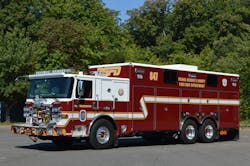When contemplating new heavy rescue apparatus, one of the first design criteria is to determine the length of the rescue body, followed by the preferred body material of either aluminum or stainless steel.
For fire/rescue departments that have operated heavy rescue or squad apparatus for several years, their experience in their community often guides these decisions based on their equipment cache, staffing model and response protocols.
These criteria, along with the demographics of the response district, planned new equipment and maintenance records, all assist in defining the mission of the heavy rescue/squad vehicle.
The fire apparatus industry has developed standard body designs that are based on the length and height of the rescue body for both walk-around and walk-in rescue vehicles. Over the years, departments that operated with a 16–18-foot body would lean toward purchasing a larger 22-foot apparatus, with the hope that the larger body not only would accommodate their present equipment but would provide a 15 percent–20 percent margin for future growth and changes in rescue and extrication tool technology. Although this “bigger is always better” philosophy works in some cases, the longer apparatus body still might not provide the appropriate size and compartment configuration to accommodate the department’s tools and equipment.
Often, departments simply choose the largest body that’s available and then work backward, to make the tools and equipment fit within the allocated space. This often results in a mega-size apparatus that carries everything but doesn’t allow access to tight areas within the community or simply can’t maneuver in locations where older vehicles easily could fit. More than ever, apparatus committees must evaluate the service needs of their first-due areas and temper this with practical application of situational awareness to provide for a well-designed apparatus.
NFPA 1901: Standard for Automotive Fire Apparatus refers to heavy rescues and squad vehicles as “Special Service Apparatus.” The sole reference to vehicle size is the requirement to have a minimum of 120 cubic feet of storage space, which easily could be accomplished with a walk-around body on a Class 5 truck chassis that has a gross vehicle weight rating (GVWR) of 19,500 lbs. In Table 12.1.2, the NFPA addresses the minimum equipment payload allowance for Special Service Apparatus based on the GVWR of the vehicle. The weight allowance ranges from 2,000 lbs. for a 10,000–15,000-lb. unit up to 10,000 lbs. for a vehicle that has a GVWR of more than 60,001 lbs. The most common benchmarks are 6,000–8,000-lb. units in the 40,001–60,000-lb. range.
Because these payload allowances represent a minimum amount, department apparatus committees must clearly identify their requirements for tool and equipment storage along with a detailed inventory of all of the equipment, including the dimensions and weights for each of the items. This information should be shared with all of the prospective apparatus manufacturers to determine the appropriate front and rear axle ratings that are required to accommodate all of the equipment. This is the first step in the process to evaluate the requirement for a single- or tandem-axle rescue apparatus.
It’s helpful to have the prospective manufacturer provide shipping weights for completed vehicles, which would indicate the front and rear axle weights, prior to mounting of the department’s equipment. These weight tickets are invaluable to assess the available payload that can be carried, and they are utilized to determine whether the proposed chassis components are adequate to safely carry personnel and the desired equipment payload.
When reading a manufacturer’s specifications, remember that all dimensions aren’t necessarily equal. Some specifications reflect the overall compartment dimensions in inches for the height, width and depth of each area. These numbers, although impressive, might not take into consideration the loss of height because of headers or the roll door shutter and the clear door opening past hinged doors. In addition, the compartment depth should be the clear, usable space for storage with the door closed. The use of slide-out trays for easier access must allow for the height of the slide mechanisms, the thickness of the tray and the side clearances that are required to pass through the door opening. Some of these dimensions aren’t provided in specifications that are provided by apparatus manufacturers, so they must be determined after consultation with their sales personnel and engineering staff.
After the specific compartment dimensions are established, you can begin to lay out your tools and equipment within each compartment area. If you already developed the apparatus inventory of equipment, including dimensions and weights, you can lay out each compartment shelf, tray and tool board space via at least two methods.
Several manufacturers and equipment mounting companies can provide a computer-aided design (CAD) drawing for each internal compartment body area that’s on the vehicle. These CAD drawings can be of great assistance to ensure that the department’s equipment can be safely mounted in each location before any metal is sheared.
Another technique, which can be accomplished in the fire station, is to mark out on the apparatus bay floor with tape each surface area, such as an adjustable shelf, tray or wall area, and locate the desired equipment within the space. Documentation of the work to compartment layout should include digital images and a listing of the appliances and equipment for each location.
Once this work is complete, the apparatus committee can discern intelligently the differences between a single-axle and a tandem-axle vehicle.
Each style of rescue apparatus has benefits and drawbacks as follows.
On the single-axle plus side, because most departments operate with at least one single-axle apparatus, assigned drivers/chauffeurs/technicians are familiar with the operating characteristics of a single-axle vehicle. Also, rescue apparatus that are configured with a single axle and that have a wheelbase between 200–230 inches easily can accommodate equipment payloads of 8,000 lbs. Although slightly longer than a standard pumper, these units can operate safely in urban environments with enhanced front-axle cramp angles, to improve turning radius in tight areas. With many communities introducing traffic circles in lieu of signal-controlled intersections, maneuverability of the apparatus, including angle of approach and departure, is an important consideration during the design process.
For departments that desire to carry tool and equipment payloads in excess of 10,000 lbs. based on their first-due response area needs, the tandem-axle rescue apparatus clearly is a better choice. Such a vehicle provides increased compartment space throughout as well as additional braking capability and better vehicle handling.
Both single- and tandem-axle heavy rescues that are configured with four-door, raised-roof cabs, along with extended front bumper extrication compartments, are susceptible to weight-balance issues on the front and rear axle loading. Front axle ratings of as much as 24,000 lbs. frequently are required because of the cab and chassis weight along with the weight of the personnel, the vehicle body and the equipment that’s carried in these areas.
Depending on the location of fixed and portable equipment in the vehicle body, it might be necessary for the heavy rescue body builder to provide counterbalance weight behind the rear axle. This not only accomplishes the addition of weight to the rear of the apparatus but the removal of weight on the front axle, too. Typically, this isn’t called out in the contract specifications, but it might be needed to provide reasonable weight balance from front to rear on the vehicle once all of the tools and portable equipment are provided.
Prior to contract, the department should require the bidder to provide a detailed weight analysis on the apparatus to include all of the fixed and portable equipment that would be supplied by the department. This projected weight should be verified at the final inspection. If sufficient equipment weight isn’t available, sandbags or shot bags should be loaded onto the apparatus to simulate the missing equipment. Prior to final acceptance, the completed and fully equipped vehicle should be weighed, including personnel, on a certified scale to validate the in-service weight of the rescue apparatus.
Designing a heavy rescue is a detailed and time-consuming process. It requires the committee to review the department’s staffing and deployment practices as well as to confirm the required tools and equipment that will meet the operational needs of the department for the planned life cycle of the apparatus.
Rescue tool technology has changed dramatically over the past decade, with an increase in the use of stabilization struts and battery-powered tools and equipment. Each requires a different mounting footprint than earlier versions.
All of these changes have affected the individual compartment spaces on apparatus, which ultimately determine which style of rescue body is the appropriate one for the department. Plan accordingly. You only get one chance to make the correct choice.
About the Author

Tom Shand
TOM SHAND, who is a Firehouse contributing editor, is a 36-year veteran of the fire service. He works with Michael Wilbur at Emergency Vehicle Response, consulting on a variety of fire apparatus and fire department master-planning issues. Shand is a member of the Firehouse Hall of Fame.




